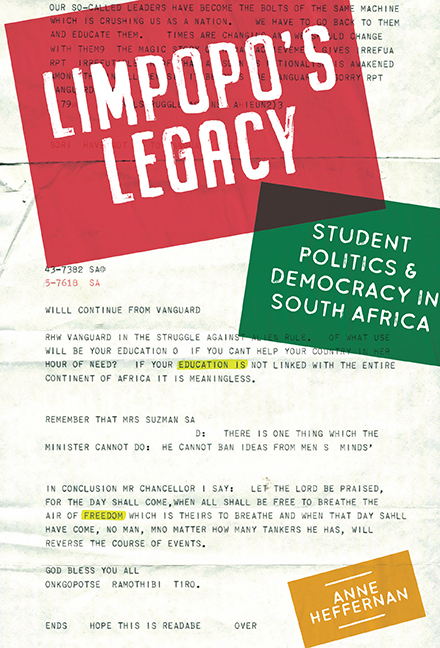Book contents
- Frontmatter
- Dedication
- Contents
- Acknowledgements
- Abbreviations and Acronyms
- Map of the north-eastern Bantustans showing the location of Limpopo
- Introduction
- 1 Turfloop, Crucible of Change
- 2 Centre of the Storm
- 3 Africanization: The New Face of Turfloop
- 4 Black Consciousness in Decline
- 5 Congresses and Comrades
- 6 Populism and the New Youth League
- 7 Julius Malema and Youth Politics in the New Limpopo
- Epilogue: Legacies of Limpopo
- Bibliography
- Index
6 - Populism and the New Youth League
Published online by Cambridge University Press: 23 July 2019
- Frontmatter
- Dedication
- Contents
- Acknowledgements
- Abbreviations and Acronyms
- Map of the north-eastern Bantustans showing the location of Limpopo
- Introduction
- 1 Turfloop, Crucible of Change
- 2 Centre of the Storm
- 3 Africanization: The New Face of Turfloop
- 4 Black Consciousness in Decline
- 5 Congresses and Comrades
- 6 Populism and the New Youth League
- 7 Julius Malema and Youth Politics in the New Limpopo
- Epilogue: Legacies of Limpopo
- Bibliography
- Index
Summary
In 1987 activists still languished under the state of emergency that had facilitated nationwide crackdowns the previous year, including the one that halted the Sekhukhuneland youth revolt. The UDF and its allies found themselves in a ‘holding operation’, trying to weather the detention of thousands of local and national activists, while maintaining a public profile. Its chief success in this regard came in the formation of a new organization: the South African Youth Congress (SAYCO) was created to unite all the Charterist youth groups under a single banner. It aimed to bring together the disparate local congresses discussed in Chapter 5. Though many of these had been allied through their mutual affiliation to the UDF, SAYCO provided the first opportunity for them to organize around the common identity of youth.
Meanwhile, on university campuses like Turfloop, Charterism was quickly becoming the dominant political ideology among student activists. The Azanian Students’ Organisation (AZASO) was consolidating its position against its Africanist and Black Consciousness-adherent competitors, most notably the Azanian Students’ Movement (AZASM). As Saleem Badat and Shaun Johnson have each argued, by 1986 AZASO was characterized by high levels of ‘organizational confidence’ and a renewed impulse towards ideological purity. By late 1986 AZASO leaders took the decision to change their organization's name to the South African National Students’ Congress (SANSCO) in order to bring it more firmly into the Charterist fold by including congress in the name, and to jettison the last nominal tie to their Black Consciousness roots: the use of ‘Azania’ rather than ‘South Africa’. As we have seen in the debates around the naming of COSAS, naming was an important aspect for any youth organization, and it was the first and most public declaration of a group's political affiliations. In the case of AZASO, the renaming to SANSCO sought to do just that, but it did not signify any changes in policy. These had already been consolidated after its break with AZAPO in 1980. In fact, the change was explicitly in name only. AZASO had been a firmly Charterist organization since its break with AZAPO; now its name finally reflected those affiliations.
- Type
- Chapter
- Information
- Limpopo's LegacyStudent Politics & Democracy in South Africa, pp. 187 - 208Publisher: Boydell & BrewerPrint publication year: 2019



